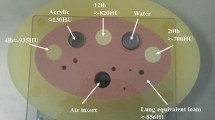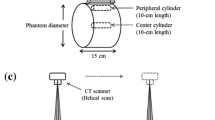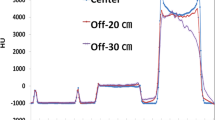Abstract
Purpose
This study evaluated the effectiveness of patient dose reduction tools on a 256-slice computed tomography scanner (Brilliance iCT, Philips).
Materials and methods
The performance of the Brilliance iCT scanner was described in terms of cumulative dose and dose-normalised contrast-to-noise ratio (CNRD). The efficiency of automatic tube current modulation (Z-Dom and D-Dom), shaping filters (SmartShape and IntelliBeam) and asymmetric collimator (Eclipse) was evaluated using appropriate phantoms.
Results
The scattered radiation contribution from the peripheral regions to the cumulative dose is not negligible. The CNRD is 20 % better compared to a traditional 16-slice scanner, with a dose reduction of 40 %. The application of shaping filters decreases the dose in the peripheral regions. The application of D-Dom and Z-Dom modulations reduces the current–time product (mAs) values by 23 and 18 %, respectively, but they are not yet integrated. The over-ranging effect is not negligible, despite the use of an Eclipse asymmetric collimator.
Conclusions
Brilliance iCT dose reduction tools are efficient, but should be analysed carefully and used correctly.






Similar content being viewed by others
References
Compagnone G, Angelini P, Domenichelli S (2012) Radiation dose to the population of the Emilia-Romagna region from medical exposure. Radiol Med 117:312–321
Mettler FA Jr, Wiest PW, Locken JA, Kelsey CA (2000) CT scanning: patterns of use and dose. J Radiol Prot 20(4):353–359
NCRP (2009) Report No. 160. On increased average radiation exposure of the US population
Shrimpton PC, Jones DG, Hiller MC et al (1991) Survey on CT practice in the UK: part 2; dosimetric aspects. Chilton, Oxon, NRPB report R-249
National Research Council (2006) Health risks from exposure to low levels of ionizing radiation: BEIR VII-Phase 2. Committee to Assess Health Risks from Exposure to Low Levels of Ionizing Radiation. Washington, DC: National Academies Press
Berrington de Gonzalez A, Mahesh M, Kim K-P et al (2009) Projected cancer risk from computed tomographic scans performed in the United States in 2007. Arch Intern Med 169:2071–2077
Smith-Bindman R, Lipson J, Marcus R et al (2009) Radiation dose associated with common computed tomography examinations and associated lifetime attributable risk of cancer. Arch Intern Med 169:2078–2086
Philips Healthcare (2009) The Brilliance iCT and DoseWise strategies—simplification of dose management with optimized image quality. White Paper
International Standard IEC 60601-2-43 (2010) Medical Electrical equipment-Part 2-43: Particular requirements for the safety of X-ray equipment for interventional procedures. II edition
IPEM, Report No. 32. Measurement of the performance characteristics of diagnostic X-ray systems used in medicine. Part III: Computed Tomography X-ray Scanners. II edition, 2003
AAPM (2010) Report No. 111. Comprehensive methodology for the evaluation of radiation dose in X-ray computed tomography: report of AAPM Task Group 111: the future of CT dosimetry
Rampado O, Garelli E, Ropolo R (2010) Computed tomography dose measurements with radiochromic films and a flatbed scanner. Med Phys 37:189–196
Kalender WA, Deak P, Kellermeier M et al (2009) Application and patient size-dependent optimization of X-ray spectra for CT. Med Phys 36:993–1007
AAPM (2011) Report No. 204. Size-specific dose estimates (SSDE) in paediatric and adult body ct examinations
European Commission (2000) EUR 16262 EN. European Guidelines on quality criteria for computed tomography
Schilham A, van der Molen AF, Prokop M, de Fong HW (2010) Overranging at multi-section CT: an underestimated source of excess radiation exposure. RadioGraphics 30:1057–1067
De Denaro M, Bregant P (2011) Dosimetric evaluation of a 320 detector row CT scanner unit. Radiol Oncol 45:64–67
Perisinakis K, Seimenis I, Tzedakis A et al (2013) The effect of head size/shape, mis-centering, and bow-tie filter on peak patient tissue doses from modern brain perfusion 256-slice CT: how can we minimize the risk for deterministic effects? Med Phys 40:011911
Conflict of interest
Anna Radice, Claudio Ielasi, Gabriele D’Andrea, Nicoletta Paruccini, Andrea Crespi declare no conflict of interest.
Author information
Authors and Affiliations
Corresponding author
Rights and permissions
About this article
Cite this article
Radice, A., Ielasi, C., D’Andrea, G. et al. Dosimetric evaluation of a 256-slice computed tomography scanner. Radiol med 119, 871–877 (2014). https://doi.org/10.1007/s11547-014-0400-5
Received:
Accepted:
Published:
Issue Date:
DOI: https://doi.org/10.1007/s11547-014-0400-5




